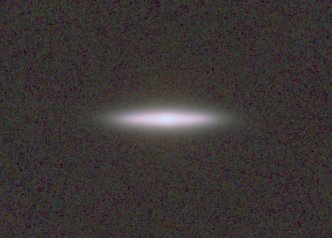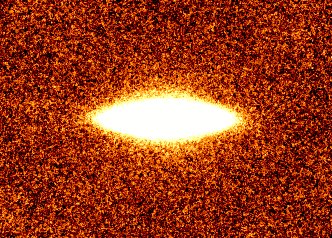 |
 |
The outermost stellar haloes of galaxies
Beyond their spectacular spiral arms and their bright central
bulges, spiral galaxies are embedded in extremely faint stellar
haloes, that can reveal tantalizing clues to how the galaxies formed.
This elusive compoment has long defied astronomers' efforts to
characterize it, but scientists at the Max-Planck-Institut fuer
Astrophysik have recently developed new techniques which exploit the
wealth of data in the Sloan Digital Sky Survey to pin down the
properties of the luminous haloes around spiral galaxies with
unprecedented accuracy. Their results have now been confirmed by the
Hubble Ultra Deep Field data, the deepest view of the Universe
ever.
In the currently favoured cosmological framework galaxy formation
proceeds hierarchically. Small protogalaxies form first and then
merge, forming stars and accreting material until they eventually
reach the status of "adult" galaxies, as seen around us in the local
universe. Adult galaxies come in many different shapes, from
elliptical star piles, to disc-like spiral galaxies and irregular,
almost chaotic systems. As a by-product of their violent assembly, a
significant fraction of the stars in a galaxy is expected to be thrown
out to large distances, forming a stellar halo. Observing the
properties of these halo stars can reveal when and how the galaxy was
assembled and clarify the physical mechanisms that govern galaxy
formation.
The stellar halo around our own Galaxy, the Milky Way, has been
studied since the 1950's, and progress in observational techniques
over the last few years has provided a detailed and rather surprising
picture of its structure. Rather than being smooth and regular many of
the stars lie in streams which seem to be the remnants of disrupted
dwarf companion galaxies. This structure has strongly shaped current
ideas about how the Milky Way formed. But how far can we generalize
such models to other galaxies than the Milky Way? Do all spiral
galaxies have a stellar halo? If so, do all stellar haloes have
similar properties? Due to the extreme faintness of the halo (its
surface brightness, i.e. the luminosity emitted per unit area, is
several hundred times fainter than in the central regions of the
galaxy) observations are very difficult and are so far available only
for a few nearby galaxies.
Using the wealth of data provided by the Sloan Digital Sky Survey
( SDSS), we have
developed a new technique which stacks images of a large number of
galaxies in order to increase sensitivity, on average, to the faint
light from their outer parts. Our sample consists of 1054 spiral
galaxies seen edge-on. The light from their haloes is then
uncontaminated by superposed emission from the bright discs. We
clearly detect a mean stellar halo in the stacked images, and its
structural properties are quite similar to those of the few, known,
individually observed spiral haloes. The statistical nature of our
method enables us to quote results for "typical" galaxies and to
assess the ubiquity of stellar haloes around spirals. SDSS), we have
developed a new technique which stacks images of a large number of
galaxies in order to increase sensitivity, on average, to the faint
light from their outer parts. Our sample consists of 1054 spiral
galaxies seen edge-on. The light from their haloes is then
uncontaminated by superposed emission from the bright discs. We
clearly detect a mean stellar halo in the stacked images, and its
structural properties are quite similar to those of the few, known,
individually observed spiral haloes. The statistical nature of our
method enables us to quote results for "typical" galaxies and to
assess the ubiquity of stellar haloes around spirals.
 |
 |
|
Fig. 1:
The "mean" galaxy image which results from the stacking of 1054
galaxies in the SDSS. In the left panel the images taken in three
different bands are composed in a pseudo-colour image that mimics the
colour the human eye would see. The very thin disc, seen in the edge-on
orientation, dominates the emission of the galaxy. In the right panel we
have streched the intensity levels and used false colours to emphasize
the faint halo emission surrounding the disc.
|
Are our results consistent with the hierarchical scenario of galaxy
formation? Careful theoretical calculations of the structure expected
will be needed to get a definitive answer. Our results include some
definite surprises. For example, the colours of the extended halo
emission are not easily explained by standard models of stellar
populations. Although this might, in principle, indicate a problem
with our stacking analysis, a recent study of an edge-on disc galaxy
in the  Hubble Ultra Deep
Field, the deepest view of the Universe ever, indicates similar
colours for the stellar halo in this individual system. Hubble Ultra Deep
Field, the deepest view of the Universe ever, indicates similar
colours for the stellar halo in this individual system.
 |
 |
|
Fig. 2:
As in Fig. 1, in the left panel we show the pseudo-colour image of an
edge-on disc galaxy (z=0.32) in the Hubble Ultra Deep Field. Most of
the light comes from bright thin disk which displays spiral arms and
dust lanes. In the right panel we stretch the intensity levels in
order to show the faintest emission (note that the regions
corresponding to sources other than the galaxy have been blanked
out). Although this image is shallower than the SDSS stacking by a
factor of approximately 5, the halo emission is apparent and the
similarity between the two observations is striking.
|
Stefano Zibetti, Simon D. M. White, and Annette M. N. Ferguson
Further reading:
S. Zibetti, S. D. M. White, J. Brinkmann
"Haloes around edge-on disc galaxies in the Sloan Digital Sky Survey",
2004, MNRAS, 347, 556
S. Zibetti and A. M. N. Ferguson
"A faint stellar halo around an edge-on disc galaxy in the Hubble Ultra Deep Field",
MNRAS accepted (astro-ph/0406207)
|
 |
 |





